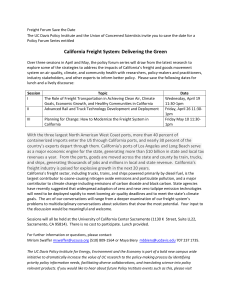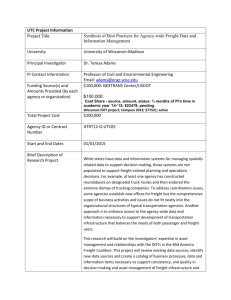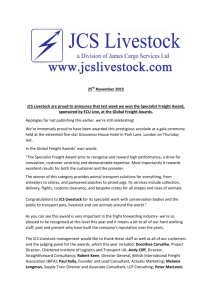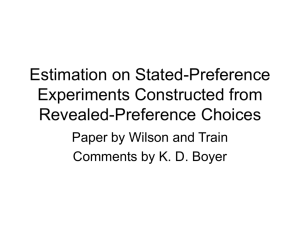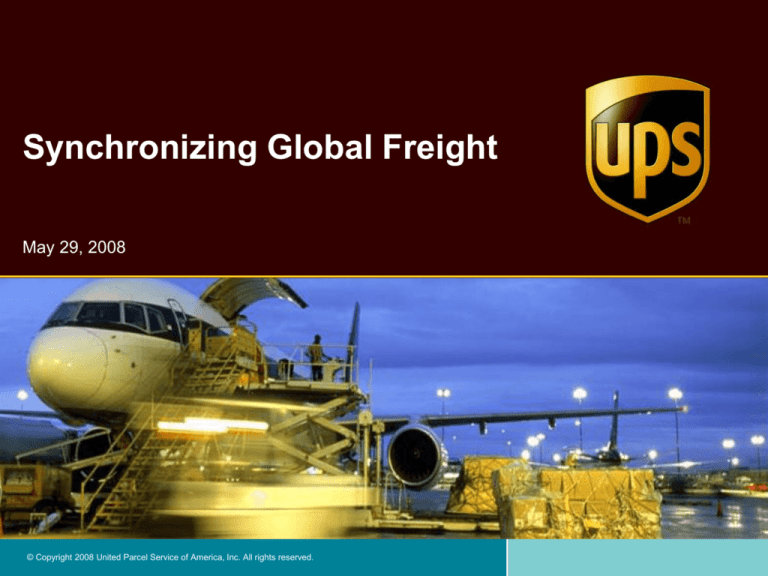
Synchronizing Global Freight
May 29, 2008
© Copyright 2008 United Parcel Service of America, Inc. All rights reserved.
Enabling Global Commerce
UPS:
UPS Supply Chain Solutions:
World’s largest package delivery company
and a global leader in supply chain services
• A global provider of integrated logistics
and supply chain solutions
• Revenue of $49.7 billion in 2007
• Revenue of $8.4 billion
• Moves 6% of U.S. gross domestic product
• Operations in 120 countries with over
1,033 facilities and 38 million square feet
of warehouse space
• Serves more than 200 countries and
territories around the world
• Customs brokerage services in all major
international trade locations
• 7.9 million customers daily
• 93,637 ground vehicles
• Global air and ocean freight forwarder and
a leading Non-Vessel Operating Common
Carrier
• 268 aircraft - World’s 9th largest airline
• 101 years of experience
Logistics and
Distribution
International
Trade
Services
Supplier
Management
North American
Air Freight
International
Air Freight
Truckload
Road Freight
Ocean
Freight
LTL Road
Freight
Small
Package
Information
Management
Trade
Financing
2
The Cost of the Global Supply Chain
Freight and transportation accounts for an average 4.36% of Cost of
Goods Sold (COGS). This is the largest and most actionable area for
near-term supply chain improvement.
Supply Chain Element
Spend
Freight and Transportation - All Modes
4.36% of sales
Warehousing
1.8% of sales
Order Entry / Customer Service
.55% of sales
Administration
.36% of sales
Inventory Carrying Costs
2.07% of sales
Total Average Supply Chain Cost
9.14% of sales
Sources: CASS, Stephens, Herbert W. Davis
3
Average Shipper Freight Spend by Mode
Twice a decade 100,000 businesses across all freight shipping segments
are asked to quantify their transportation spend across modes.
Average Freight Spend, International and Domestic
Other
14%
TL / LTL
19%
Rail Freight
4%
Ocean Freight
28%
Sources: Shipper Surveys, U.S. DoT / U.S. DoC
Air Freight
35%
4
Freight Routing: Different Modes for Different Needs
These modes each deliver a different balance of Effectiveness (speed and
precision) and Efficiency (shipment expense and per-carton cost)
Effectiveness
10x
Cost
Efficiency
10x
Time
5
Freight Routing: One Size Does Not Fit All
26
28
40
Seasonal
Merchandise
Replenishment
Merchandise
Seasonal
16
Margin
7
Geography
6
High Velocity
Merchandise
Demand
Time in Transit
5
High Margin
Merchandise
Basic Solutions
3
Complex Solutions
E: Competitive Analysis
Appendix
Customer Ready Store Ready Pooler Ready DC Ready
High Service Standards
Low Service Standards
Shelf Life
2 November 2004
RWG Draft (Confidential)
55
6
Example: An Integrated, Mode-Shifting Solution
PICKUP /
CONSOLIDATE
SHIPMENTS
CLEAR
CUSTOMS
DECONSOLIDATE
SHIPMENTS
FINAL
DELIVERY
FULL VISIBILITY: End-to-end tracking provided throughout the supply chain.
Freight and
individual
packages are
picked up and
consolidated
Consolidated
shipment crosses
the border in a
single customs
clearance
Freight moves
via LTL
Packages enter
UPS package
delivery
network
Package and LTL
shipments are
delivered direct to
multiple retail
stores and/or end
customers
7
Progression of Global Freight Management Strategy
Full
Supply Chain
Management
Mode-Shift
Capabilities
Multi-Modal Management
Single Mode Focus
End-to-end global supply chain cohesion, total
distribution cost management, active management
of suppliers, integrated customer and regulatory
compliance
Sea-Air, Trade Direct, DC bypass, transload,
in-transit VAS application, shortened transit,
heightened value
SKU level routing optimization, maximum
utility with lowest opportunity cost,
heightened agility, decreased disruption
Potential economy of scale at cost of
agility and responsiveness
8
Global Freight is Not a Level Playing Field
Effective management of end-to-end freight and ancillary functions can
reduce total distribution cost by up to 5%, with the same impact on profit
as a 30% increase in sales.
Retail Business Improvement Through End-to-End Supply Management
Reduced Stock-Outs
2%-8% improvement
Lower Inventory Levels
10%-40% improvement
Increased Sales
5%-20% improvement
Manufacturing Business Improvement Through End-to-End Supply Mgmt
Lower Inventory Levels
10%-40% improvement
Faster Replenishment Cycles
12%-30% improvement
Higher Sales
2%-10% improvement
Better Customer Service
5%-10% improvement
Sources: Benchmark analysis, AMR survey
9
Thank you
www.ups.com
© Copyright 2008 United Parcel Service of America, Inc. UPS, the UPS brandmark and the color brown are trademarks of Untied Parcel Service of America, Inc. All rights reserved.


